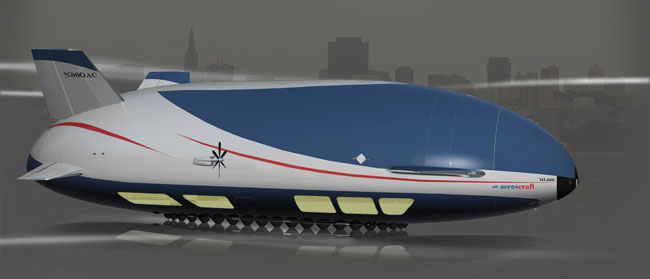Pimp My Blimp: New Luxury Airship Planned

It's a blimp. It's a plane. No, it's an airship with 5,000 square feet of living and/or cargo space, according to plans announced by a company that makes surveillance and advertising dirigibles.
The planned Aeroscraft ML866 is much more than an advertising blimp or one of those huge passenger dirigibles of the 1930s, said Edward Pevzner, business development manager at blimp-maker Worldwide Aeros Corp. It can be finished as a personal yacht, a business commuter craft or cargo carrier, he said.
But either way, it’s basically a low-maintenance, non-buoyant airship that could operate from any airport, carrying anywhere from two to maybe 20 people.
"It’s designed to get rid of all the problems associated with conventional airships, such as the need for a ground crew, mooring equipment and susceptibility to weather," Pevzner told LiveScience.
The helium lifting-gas of the Aeroscraft supports only about 70 percent of the vehicle’s weight, with the rest being carried by engines through dynamic lift produced by the shape of the hull, which resembles a fat, short surfboard.
Therefore, the airship can simply be parked on a runway or any open field that will accommodate its length and girth (210 feet long, 95 feet wide).
The floor space compares to that of the hydrogen-filled Hindenburg, the grandest of the passenger dirigibles of the 1930s, which had about 6,000 square feet of floor space on two decks inside its 804-foot-long 135-feet-wide hull until its fiery and tragic demise while landing in New Jersey in 1937.
Sign up for the Live Science daily newsletter now
Get the world’s most fascinating discoveries delivered straight to your inbox.
The disposable lift for the Aeroscraft will be about 7 tons, compared to 112 tons for the Hindenburg (most of that 112 tons was consumed by fuel, ballast and the 40-person crew).
Configured for freight, the Aeroscraft could deliver cargo to anyplace with enough open space to allow a landing, Pevzner said.
Key design points:
- The Aeroscraft will be able to cruise at about 120 mph, as opposed to 77 mph for the Hindenburg.
- With a cruising range of 3,100 miles, the Aeroscraft is not intended to cross the Atlantic, Pevzner noted. (The Hindenburg crossed it routinely.)
- The Aeroscraft can operate as high as 12,000 feet. (The Hindenburg usually cruised at 750 feet so the passengers could wave out the windows.)
- There’s no need for a ground crew. (The Hindenburg required about 250 people pulling ropes to get it on the ground.)
Aeros has not yet set a price for the Aeroscraft, but Pevzner said it would be "competitive with private jets."
Test flights are scheduled to begin in 2010. In the meantime, the company is negotiating with the Federal Aviation Administration concerning that kind of licensing the pilot and co-pilot of an Aeroscraft will need. The FAA offers different licenses for airplane pilots and blimp pilots, but the Aeroscraft will be neither, Pevzner added.










